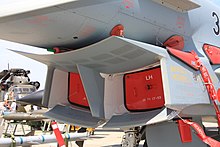| This article needs additional citations for verification. Please help improve this article by adding citations to reliable sources. Unsourced material may be challenged and removed. Find sources: "Splitter plate" aeronautics – news · newspapers · books · scholar · JSTOR (April 2013) (Learn how and when to remove this message) |


A splitter plate is a component in some jet aircraft, used to control the airflow into the engine. Where the engine air intake is mounted partway back along the fuselage or under the wing, the splitter plate diverts the boundary layer away from the engine intake. It is a form of boundary layer control.
Diverting the boundary layer
When a body, such as a wing or a fuselage, passes through a fluid such as the air, a boundary layer of fluid attaches to the body and moves along with it. If this layer enters the air intake of a jet engine, it can affect performance.
In order to stop this boundary layer problem from happening, a splitter plate may be used to separate the boundary layer from the fast-moving free airflow and divert it away from the engine intake.
Many splitter plates have a series of holes drilled into the surface closer to the engine side of the intake. Suction is applied to these holes, further reducing the boundary layer.
Airplanes
- General Dynamics F-16 Fighting Falcon
- HAL Tejas
- Saab JAS 39 Gripen
- Eurofighter Typhoon
- Chengdu J-10A
- McDonnell Douglas F-4 Phantom II
- North American XB-70 Valkyrie
- Avro Canada CF-105 Arrow
- Mikoyan-Gurevich MiG-23
- Mikoyan Project 1.44
- Sukhoi Su-15
- Shenyang J-8B Finback
See also
- Index of aviation articles
- Inlet cone
- Intake ramp
- Diverterless supersonic inlet
- Diffuser (automotive) for automotive splitter plates
References
- Rogoway, Tyler (2018-05-18). "The YF-23's Air Inlet Design Was Its Most Exotic Feature You Never Heard Of". The Drive. Recurrent Ventures. Archived from the original on 2018-05-21. Retrieved 2023-04-07.
Having holes drilled into splitter-plates wasn't new. It had been done many times in the past to remove the boundary air that began to manifest itself on the plate itself before entering the engine. For instance, the Eurofighter EF2000 has this feature on its upper splitter plate that is easy to spot. The Super Hornet also uses it on the inside of its intakes. Older aircraft, like the F-4, also used perforations on their splitter plates to remove air clinging to the intake's surface.
- Hughes, Donald L; Holztman, Jon K; Johnson, Harold J (1972). "Flight-Determined Characteristics of an Air Intake System of an F-111A Airplane" (PDF). Technical Note. D–6679. NASA. Retrieved 15 February 2013.
- Hünecke, Klaus (1997). Jet Engines. England: Airlife. pp. 76–79. ISBN 1853108340.
... the thickening of the boundary layer that develops at high angles-of-attack along the lower side of the fuselage forebody . In order to prevent low-energy flow from entering the engine, the intake had to be offset from the fuselage to free it from the boundary layer, which uninterruptedly passes along the fuselage. The intake cowl features a moderately blunt lower lip that transitions into a sharp leading-edge extension or splitter plate on the upper side (close to the fuselage).